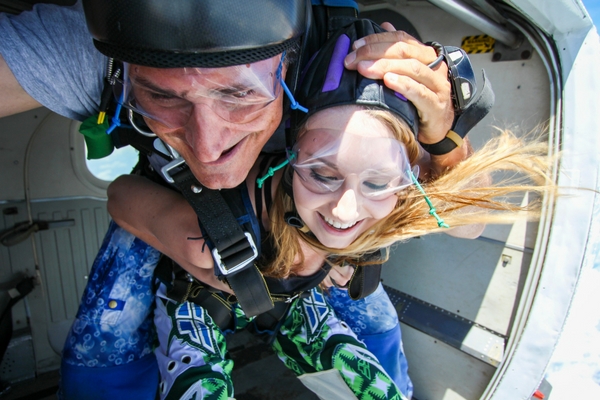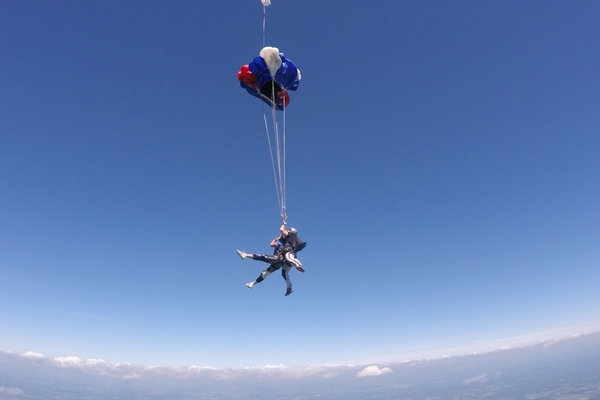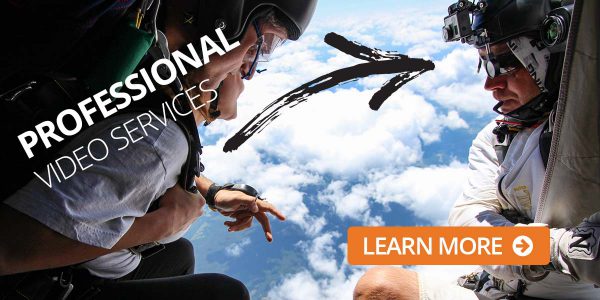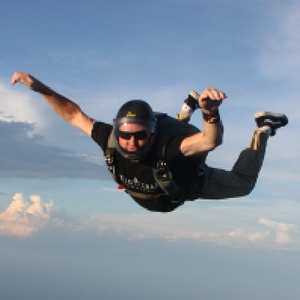
How Safe Is Tandem Skydiving?
Thursday, July 11, 2024
So you want to jump out of a perfectly good airplane, huh? Chances are the first thing you’ll wonder (or hear from your parent or partner) is something along the lines of: Is skydiving safe? And it’s a fair question!
Skydiving is serious business and should be treated as such. We understand your worries and are here to help put your mind at ease as much as possible. However, we don’t want to overshadow your/their concern as it is a crucial piece to appreciating and enjoying the journey of skydiving!
Is Skydiving Safe?
At Skydive Orange, safety is our foremost concern, regardless of whether it is your first jump or your thousandth.
Is skydiving dangerous? Skydiving – like any other extreme sport – carries inherent risk and should be approached with caution. Can it be made safer through proper education and procedures? Absolutely! It is our job as skydivers, pilots, and ground crew to mitigate those risks as much as possible through preparation and good judgment. Regardless, accidents can still happen.
In 2023, the United States Parachute Association (USPA) reported a total of 3.65 million jumps, 10 of which ended with a fatality. This calculates to a fatality rate of 0.27 per 100,000 jumps (or 1:370,000). While every fatality is a blow to our community, it should be noted that this is the lowest rate since record-keeping began in 1961. Additionally, six percent of USPA members reported injuries requiring medical treatment, with the most common being ankle injuries from poor landings.
While we, in no way, would ever say skydiving or parachuting is “safe,” we can rely on the meticulously collected data from the USPA and have confidence in our ability to manage emergencies with proper emergency procedures.

How Safe is Tandem Skydiving?
Tandem skydiving is the most popular choice for first-time skydivers. This is where the tandem student will enjoy the skydiving experience while harnessed to a highly experienced, certified tandem skydiving instructor.
We are pleased to report that tandem skydiving deaths are extremely rare. In 2023 there were zero tandem skydiving deaths, and over the last decade, there has been an average of one fatality per 500,000 jumps. Making the chance of dying on a tandem skydive about 0.002% for every 1,000 jumps. Does this make tandem skydiving safe? Well … no, but the odds are pretty dang good!
That said, there are still risks involved with tandem skydiving. The main risks of tandem skydiving are parachute malfunctions, injury on landing, injury during freefall, and unforeseen medical conditions. The most common injury in tandem skydiving is ankle injury due to a tandem student failing to lift their legs during landing and unfortunately taking the impact straight on. This is why it is important to come prepared and make sure you are in pretty good physical shape before attempting to skydive!
How Do We Mitigate Skydiving Risk?
You might have noticed that the fatality rate for experienced skydivers is higher than tandem skydiving. This is because solo skydivers have more personal responsibility and accountability: they choose what gear to jump with, are responsible for maintaining that gear, and have more freedom in the sky.
While tandem skydiving is heavily regulated by only jumping with gear that is owned and maintained by the dropzone, packed by certified rigger or parachute packers that are approved by the rigger, and they have very limited privileges. These precautions may seem a bit redundant to some, but it is only because the safety of our tandem students is our main focus and utmost priority – we will always do our best to protect you!
Let’s discuss some of the ways that we mitigate tandem skydiving risks at Skydive Orange.
Tandem Skydiving Gear is Heavily Monitored & Strictly Maintained
The biggest concern about skydiving safety is surrounded by equipment failure when in reality, skydiving accidents usually happen due to improper judgment or failure to properly perform emergency procedures. Skydiving gear has come a long, long way from the classic round parachutes thanks to continuous advancements in modern technology and the design of sophisticated safety features.
The skydiving rig is equipped with two parachutes: the main parachute and the reserve parachute. The reserve parachute is in place and ready to be deployed should the main parachute malfunction for any reason. That reserve parachute is carefully inspected and repacked every 180 days (regardless if it was used or not) by a parachute rigger certified by the Federal Aviation Administration (FAA).
Tandem skydiving gear has many safety features such as the Automatic Activation Device (AAD) that will automatically deploy the reserve parachute at a predetermined altitude and speed if the main parachute has not been deployed already for whatever reason. This helps in the case that your instructor is unable to deploy the parachute due to an injury or other unforeseen circumstances.
We Only Hire Qualified Tandem Instructors
Our team at Skydive Orange is extremely passionate and dedicated to creating a culture of safety, growth, and development. All of our tandem skydiving instructors are USPA-certified and highly experienced with over 20 thousand jumps combined and decades of experience under their belts. To earn their USPA Tandem Instructor rating, each person must go through rigorous training and must have:
- At least 500 jumps
- 3 years in the sport
- USPA D license (the highest license rating achievable)
- USPA Coach or Instructor rating
- FAA Class III Flight Medical Certificate
- Continuing education and training regarding safety protocols and skydiving techniques

Everyone Practices Emergency Preparedness
Instructors, experienced skydivers, pilots, and ground crew are all trained in how to handle emergencies should anything occur. Every tandem skydive must have a pre-jump briefing or class where the student will learn the skydiving process, safety protocols, and what to expect during the jump.
Even experienced skydivers must be aware of and understand our specific safety procedures, landing area rules, and drop zone requirements before jumping. This makes sure that everyone is on the same page and knows what is expected of them. Skydive Orange reserves the right to ground any jumper who is not following the rules of the dropzone.
We Follow Strict Policies
Things like our weather policy, weight restrictions, age requirements, dress code, and overall dropzone rules are in place to keep everyone as safe as possible. Our policies are very strict and will not waiver for any reason unless directed by the USPA through an approval process.
We Are USPA Members!
As USPA members, we must follow strict guidelines set out by the USPA and FAA and are held to the highest standard. This means staying educated on the latest skydiving techniques, and requirements, and being a direct contact to receive new policies and procedures created by our governing body. Each year before jump season, we host USPA Safety Day to keep our community in the loop on all the happenings and brush up on important skydiving safety skills.
Have more questions? Feel free to reach out to our team at Skydive Orange, we would love to help! And when you’re ready to jump, book your skydive! Blue skies, y’all.
The largest tandem skydiving center near Northern Virginia, Washington D.C. and Maryland.
Copyright © 2025, Skydive Orange, All Rights Reserved.
DropZone Web Design & Marketing by Beyond Marketing, LLC


